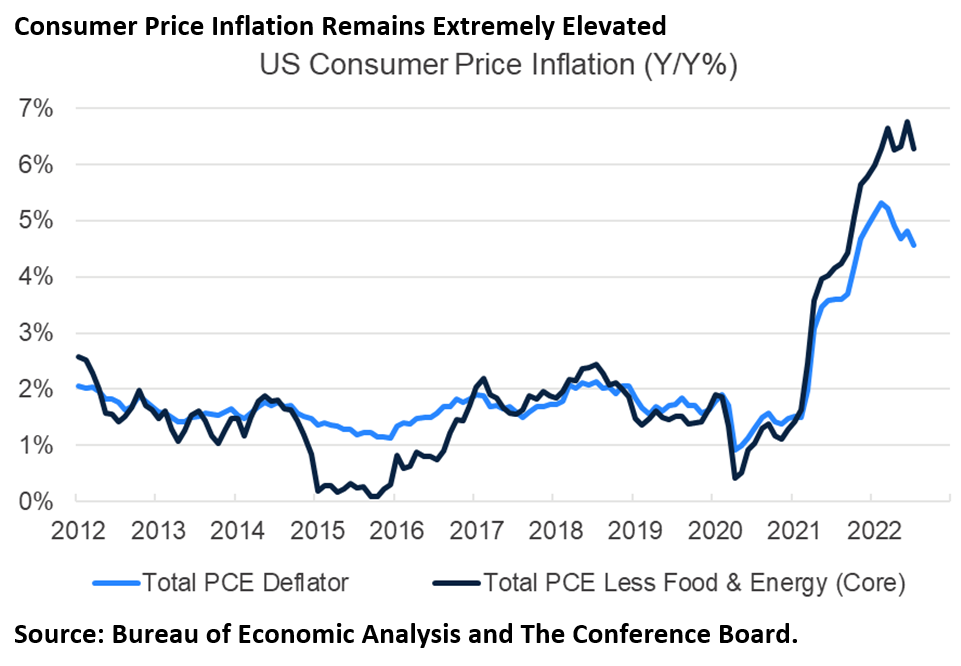-
Email
Linkedin
Facebook
Twitter
Copy Link

Loading...
Real consumer spending and income increased modestly in July starting the third quarter off on better footing compared to the end of the second quarter. However, overall consumer inflation remained near 40-year peaks driven higher by food and services prices. Less food and energy, core consumer inflation ticked lower but also remained elevated and well above the Fed’s 2-percent inflation target. Nominal consumer spending rose by 0.2 percent month-over-month in July after rising by 1.0 percent in June. In real terms, spending was also up 0.2 percent in the month, but after being flat at the end of the second quarter. Real spending on goods were 0.2 percent higher but weighed down slightly by nondurable goods, which fell in the month. Services continued to steadily rise as households rebalance their consumption of goods versus services post-pandemic. Nominal personal income increased by 0.2 percent month-over-month, but was up 0.3 percent in real terms as inflation was slightly less intense. Still, year-over-year real income growth continues to be negative, and spending is increasingly being financed by credit according to consumer credit data. The headline personal consumption expenditures (PCE) deflator dipped by 0.1 percent month-over-month, but remained near 40-year highs year-over-year at 6.3 percent. The monthly decline reflected lower prices for select durable goods and gasoline. Grocery prices continued to rise. Less food and energy, the core PCE deflator increased by 0.1 percent month-over-month but slowed to 4.6 percent year-over-year. The slower pace of increase is constructive, but still shows a glacial rate of easing in inflationary pressures. Within the detail, energy related services prices (e.g., natural gas and airline transportation) cooled, but costs for most other services, especially rents (actual and imputed), continued to levitate.Insights for What’s Ahead
Data Overview

Cutting Discretionary Spending to Offset Higher Prices
March 28, 2025
Auto Makers Hit a Tariff Speedbump
March 27, 2025
Administration acts with Congress to reverse methane fee
March 25, 2025
Fed Keeps Cutting Bias amid “Transitory” Tariff Inflation
March 19, 2025
Retail Sales Show Consumers Are More Frugal amid Uncertainty
March 17, 2025
The EU's Retaliatory Tariffs Will Hit Beef, Bourbon and More
March 14, 2025
Charts
Preliminary PMI indices show no change in weak DM growth momentum in November
LEARN MORECharts
Members of The Conference Board can access all underlying data of the Job Loss Risk Index by Industry in this Excel workbook.
LEARN MORECharts
While a US recession appears to be imminent, it will not look like any other in recent history.
LEARN MORECharts
CEOs’ views of current and future economic conditions remain pessimistic as they prepare for near-inevitable US and EU recessions.
LEARN MORECharts
The US economy appears to be on the precipice of recession.
LEARN MORECharts
Measure of CEO Confidence declined for the fifth consecutive quarter in Q3 2022 and has hit lows not seen since the start of the COVID-19 pandemic in 2020.
LEARN MOREPRESS RELEASE
US Leading Economic Index® (LEI) Fell in March
April 18, 2024
PRESS RELEASE
US Consumer Confidence Little Changed in March
March 26, 2024
PRESS RELEASE
US Leading Economic Index® (LEI) Inched Up in February
March 21, 2024
PRESS RELEASE
US Consumer Confidence Retreated in February
February 27, 2024
PRESS RELEASE
US Leading Economic Index® (LEI) Fell Further in January
February 20, 2024
PRESS RELEASE
CEO Confidence Improved in Q1 2024
February 08, 2024
